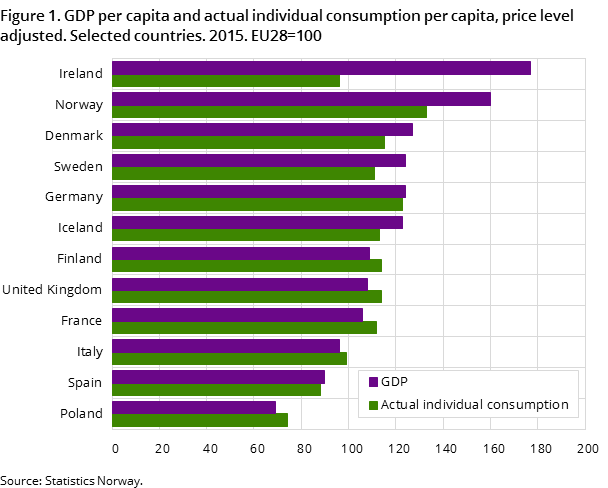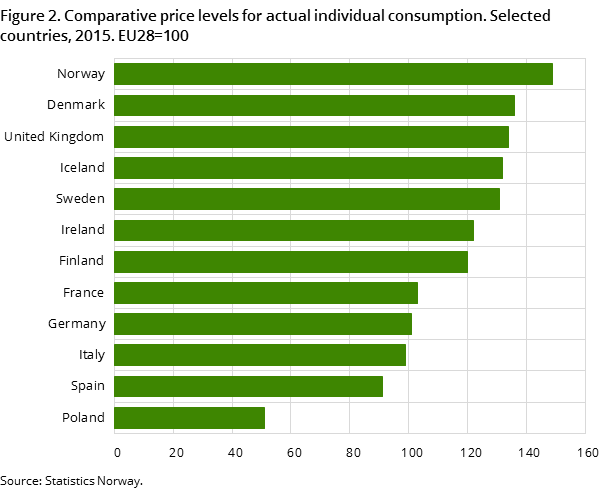Norway fourth place in GDP comparison
Published:
Within Europe, Norway’s price level-adjusted Gross Domestic Product (GDP) per capita has consistently been second to Luxembourg since the late 90s. Eurostat’s results for 2015 showed that Ireland is now second, however Norway’s actual individual consumption remains high compared to EU average.
- Full set of figures
- Comparison of price levels in Europe
The latest results from the European Comparison Programme showed that Luxembourg, Ireland, Switzerland and Norway have the highest price level-adjusted GDP per capita in Europe. In 2015, the GDP per capita for the four countries ranged from 164 to 60 per cent above the average of the 28 EU countries (EU28). The rest of the countries in the comparison basically retained their relative positions from 2014 with some exceptions. The international guidelines for the national accounts have been updated with the European system of national and regional account (ESA 2010) and published figures in 2015 are based on revised figures. See link to website in Eurostat for details regarding PPP revisions.
Norway and Ireland with largest relative changes from 2013-2015
Ireland bumped Norway out of second place in the GDP comparison. Ireland had the largest relative increase in price-level adjusted GDP per capita between 2013 and 2015, while Norway had the largest relative decrease in the same period. The change in ranking can be attributed to two factors. The Irish economy experienced a surge as significant foreign investments were recorded in 2015 due to its low corporate tax regime, and the establishment of multinational companies with high intellectual capital and a strong increase in leasing companies in air transport led to strong GDP growth. Norway on the other hand faced decreases in both the price and volume of its main export product, petroleum.
The rest of Europe basically retained their relative positions with some exceptions. It should be noted that changes over time in the ranking of countries in the GDP comparison can either be attributed to changes in the nominal GDPs, changes in the price level indicators (PPPs), changes in the population, or a combination of these factors. Countries in East and Central Europe generally have lower levels of GDP per capita compared to western European countries. There was a noticeable relative increase in price level-adjusted GDP for Croatia from 2013 to 2015.
Consumption levels highest in Luxembourg, Norway, Switzerland and Germany
Luxembourg, Norway, Switzerland and Germany lead the comparison of Actual Individual Consumption per capita in 2015, with 37, 33, 28 and 23 per cent above the average of the EU28 respectively. Actual individual consumption per capita for Norway is around 16-20 per cent higher than the other Nordic countries. The Balkan countries, with the exception of Greece, remain at the bottom of the list in the 2015 comparison. For Bosnia-Hercegovina, Albania, Macedonia and Serbia, consumption of goods and services is less than half the average for EU28. The consumption level for Montenegro, Bulgaria, Turkey, Romania, Hungary and Croatia is slightly higher, at around 40 to 50 per cent below EU28.
Switzerland and Norway again are Europe’s most expensive countries in 2015
Switzerland and Norway were Europe’s most expensive countries in 2015, with price levels 72 and 49 per cent above the EU28 average respectively. Figure 2 shows the price levels for Actual Individual consumption in selected countries. If we compare Norway’s price level with its neighbours, it is 9 per cent above the level of Denmark and 14 per cent above the level of Sweden. Other countries with relatively high price levels are Denmark, Luxembourg, United Kingdom, Iceland and Sweden, with price levels from 31 to 36 per cent above EU28.
The countries with the lowest relative price levels in the survey are situated in South Eastern Europe. In Macedonia, Albania and Bulgaria, the price levels of goods and services for actual individual consumption are slightly over a quarter of the level in Norway. Changes in the relative price levels over time can be attributed to different inflation rates in the countries. However, in many cases, the changes are due to changes in the countries’ exchange rate compared to the Euro.
Contact
-
Estrellita Rauan
-
Knut Linnerud
-
Simen Sæterdal
-
Statistics Norway's Information Centre


